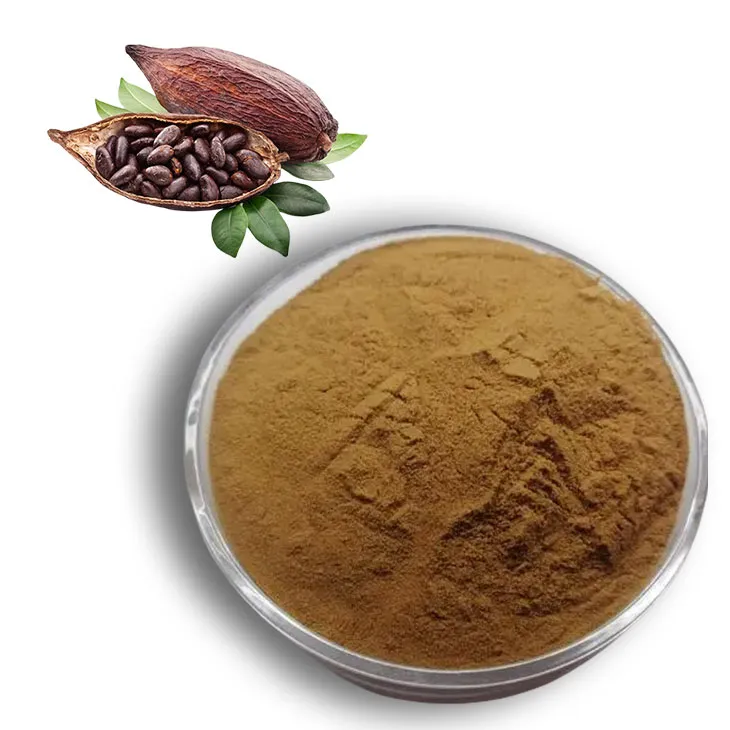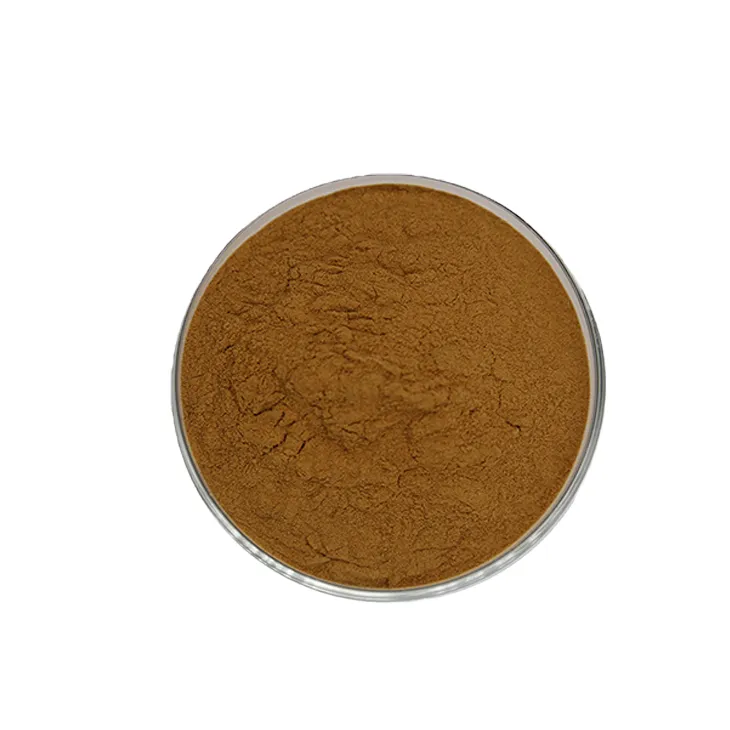- 0086-571-85302990
- sales@greenskybio.com
Components of Cocoa Extract in Fertilizers and Feeds.
2024-11-28

1. Introduction
Cocoa Extract has recently gained significant attention in the fields of fertilizers and feeds. The unique properties and rich composition of Cocoa Extract make it a potentially valuable ingredient in both sectors. The use of Cocoa Extract in fertilizers can potentially improve soil fertility, while in feeds, it can offer various benefits to livestock. Understanding the components of cocoa extract is crucial for maximizing its potential applications in these areas.

2. Origin and Extraction of Cocoa Extract
2.1 Origin
Cocoa extract is derived from the cocoa bean, which is the seed of the cacao tree (Theobroma cacao). Cacao trees are native to Central and South America but are now cultivated in many tropical regions around the world. The beans are harvested from the pods of the cacao tree and then undergo a series of processing steps to obtain the extract.
2.2 Extraction Methods
There are several methods for extracting cocoa extract. One common method is solvent extraction, where solvents such as ethanol or water are used to dissolve the desired components from the cocoa beans. Another method is mechanical extraction, which involves crushing and pressing the beans to extract the oils and other components. The extraction method can influence the composition and quality of the resulting cocoa extract.

3. Components of Cocoa Extract
3.1 Flavonoids
Flavonoids are a major component of cocoa extract. These are polyphenolic compounds that have antioxidant properties. In fertilizers, flavonoids may play a role in improving soil structure and nutrient availability. In feeds, they can have beneficial effects on animal health, such as reducing oxidative stress in livestock. Examples of flavonoids found in cocoa extract include catechins and epicatechins.
3.2 Nitrogen - Containing Compounds
Cocoa extract contains nitrogen - containing compounds, such as alkaloids and amino acids. Alkaloids like theobromine are present in cocoa extract. In fertilizers, the nitrogen from these compounds can contribute to soil fertility by providing a source of nitrogen for plants. In feeds, amino acids are essential for the growth and development of livestock, and the nitrogen - containing compounds in cocoa extract can supplement their dietary requirements.
3.3 Essential Minerals
Cocoa extract also contains essential minerals. These include potassium, magnesium, and calcium. Potassium is important for plant growth and development, and in fertilizers, the potassium in cocoa extract can help improve plant resistance to diseases and pests. In feeds, minerals are necessary for maintaining proper physiological functions in livestock. For example, calcium is crucial for bone development in animals.

4. Cocoa Extract in Fertilizers
4.1 Soil Fertility Enhancement
The components of cocoa extract can enhance soil fertility in several ways. The nitrogen - containing compounds provide a source of nitrogen, which is an essential nutrient for plants. The flavonoids may help improve soil structure by promoting the aggregation of soil particles. This can lead to better water infiltration and air circulation in the soil. The essential minerals in cocoa extract can also supplement the soil's mineral content, ensuring that plants have access to all the necessary nutrients.
4.2 Impact on Plant Growth
When used in fertilizers, cocoa extract can have a positive impact on plant growth. The availability of nutrients from the cocoa extract can promote healthy root development, which in turn leads to better nutrient and water uptake by the plants. The antioxidant properties of flavonoids may also protect plants from oxidative damage caused by environmental stresses such as drought or high temperature. This can result in increased plant productivity and quality.

5. Cocoa Extract in Feeds
5.1 Source of Bioactive Compounds
Cocoa extract serves as a source of bioactive compounds in feeds. The flavonoids, with their antioxidant properties, can help reduce oxidative stress in livestock. This can improve the overall health and well - being of the animals. The nitrogen - containing compounds can also contribute to the protein content of the feed, which is essential for muscle development and growth in livestock.
5.2 Influence on Animal Products
The use of cocoa extract in feeds can also have an impact on the quality of animal products. For example, in poultry, it may improve the quality of eggs, such as increasing the yolk color and nutritional value. In livestock, it may enhance the quality of meat, such as improving its tenderness and flavor. This is due to the various bioactive compounds present in cocoa extract that can be transferred to the animal products.
6. Challenges and Considerations
6.1 Quality Control
Ensuring the quality of cocoa extract used in fertilizers and feeds is crucial. There need to be strict quality control measures in place to monitor the composition and purity of the extract. Variations in the origin of cocoa beans and extraction methods can lead to differences in the quality of the extract, which can affect its performance in fertilizers and feeds.
6.2 Cost - Effectiveness
The cost - effectiveness of using cocoa extract in fertilizers and feeds is another consideration. The extraction process can be expensive, and the availability of cocoa beans may also be limited in some regions. Therefore, it is necessary to find ways to optimize the extraction process and source cocoa beans in a cost - effective manner to make the use of cocoa extract more viable in these industries.
7. Conclusion
In conclusion, cocoa extract contains a variety of components such as flavonoids, nitrogen - containing compounds, and essential minerals that have potential applications in fertilizers and feeds. In fertilizers, it can enhance soil fertility and plant growth, while in feeds, it can provide bioactive compounds for livestock and improve the quality of animal products. However, there are challenges such as quality control and cost - effectiveness that need to be addressed to fully realize the potential of cocoa extract in these sectors. Further research and development are needed to optimize the use of cocoa extract and to explore its full range of benefits in fertilizers and feeds.
FAQ:
What are the main components of cocoa extract?
The main components of cocoa extract include flavonoids, nitrogen - containing compounds, and essential minerals.
How do the components of cocoa extract enhance soil fertility in fertilizers?
The components in cocoa extract, such as nitrogen - containing compounds and essential minerals, can provide necessary nutrients for the soil. Flavonoids may also have positive effects on soil microbial communities, which in turn contribute to soil fertility enhancement.
What makes cocoa extract a valuable source of bioactive compounds for livestock in feeds?
Cocoa extract contains various bioactive compounds like flavonoids. These compounds can have beneficial effects on the health and growth of livestock, for example, by improving their immune function or antioxidant capacity.
How does the extraction method of cocoa extract affect its components for use in fertilizers and feeds?
Different extraction methods can lead to variations in the concentration and purity of the components. For example, a more refined extraction method may result in a higher concentration of flavonoids, which could potentially enhance the effectiveness of cocoa extract in both fertilizers and feeds.
Can the components of cocoa extract in fertilizers and feeds have any negative impacts?
While cocoa extract has many potential benefits, improper use could lead to some negative impacts. For example, excessive application of fertilizers containing cocoa extract may cause an imbalance in soil nutrients. In feeds, if not properly dosed, it could potentially cause adverse reactions in livestock.
Related literature
- Title: The Role of Cocoa Extract Components in Soil Health and Plant Growth"
- Title: "Bioactive Compounds in Cocoa Extract for Livestock Nutrition"
- Title: "Effects of Cocoa Extract in Fertilizer Formulations on Crop Yield"
- ▶ Hesperidin
- ▶ citrus bioflavonoids
- ▶ plant extract
- ▶ lycopene
- ▶ Diosmin
- ▶ Grape seed extract
- ▶ Sea buckthorn Juice Powder
- ▶ Beetroot powder
- ▶ Hops Extract
- ▶ Artichoke Extract
- ▶ Reishi mushroom extract
- ▶ Astaxanthin
- ▶ Green Tea Extract
- ▶ Curcumin Extract
- ▶ Horse Chestnut Extract
- ▶ Other Problems
- ▶ Boswellia Serrata Extract
- ▶ Resveratrol Extract
- ▶ Marigold Extract
- ▶ Grape Leaf Extract
- ▶ blog3
- ▶ blog4
-
The Best Apple Cider Vinegar Powder in 2024.
2024-11-28
-
The Maca Extract Brands Most Worth Buying.
2024-11-28
-
The best cactus extract on the market.
2024-11-28
-
High - quality lily extract products.
2024-11-28
-
Tinospora cordifolia extract
2024-11-28
-
Citrus Aurantium Extract
2024-11-28
-
Polygonum Cuspidatum Extract
2024-11-28
-
Lily extract
2024-11-28
-
Phellodendron Extract
2024-11-28
-
Angelica sinensis extract
2024-11-28
-
White Willow Bark Extract
2024-11-28
-
Peppermint Extract Powder
2024-11-28
-
Pine bark Extract Powder
2024-11-28
-
Kidney Bean Extract
2024-11-28





















